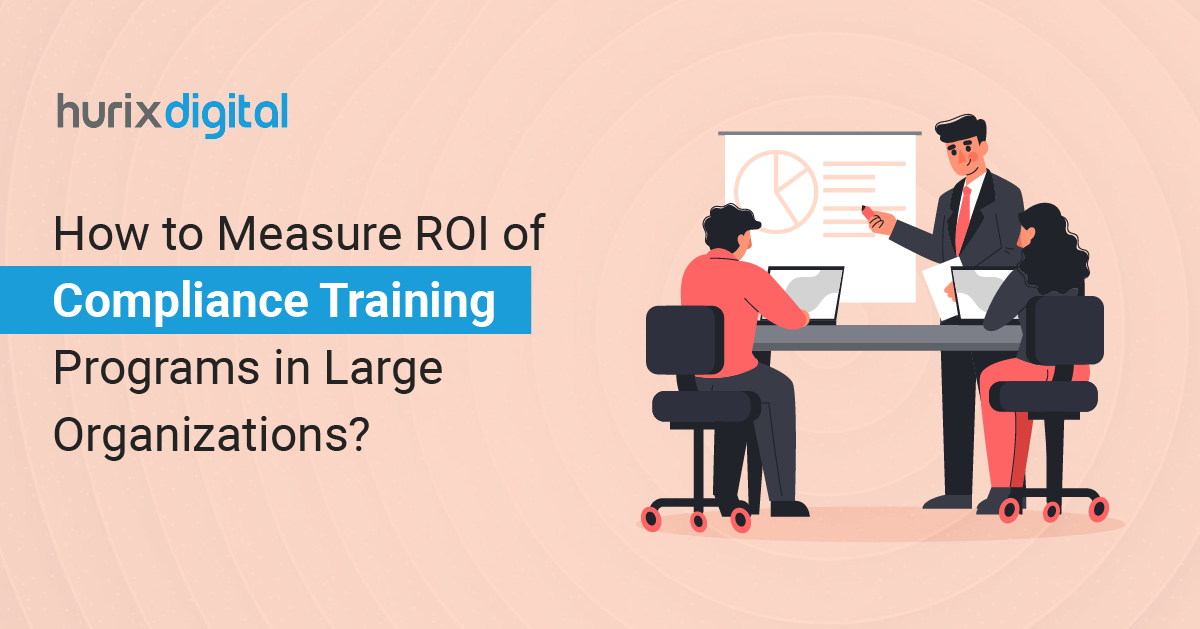
How to Measure ROI of Compliance Training Programs in Large Organizations?
Summary
Discover 7 methods to evaluate and enhance the ROI of compliance training in regulated sectors, using digital and data-driven strategies, skills, and performance assessments.
The digital economy has boosted businesses worldwide. However, companies must follow additional guidelines to stay compliant and financially secure. For instance, sectors such as healthcare, financial services, education, Information Technology (IT), and hospitality are highly regulated.
The inability to comply with regulations can cost companies millions of dollars in penalties, litigation, and reputation management. They also risk a shutdown. Hence, companies must regard compliance training seriously and not merely as a mandatory aspect of training.
The corporate compliance training market is estimated to be valued at $4.79 billion by 2023. In this blog, we recommend seven ways to measure and increase the ROI of compliance training for long-term business sustainability.
Table of Contents:
- What is Compliance Training?
- 7 Ways to Measure ROI of Compliance Training Programs
- How to Boost ROI of Compliance Training Programs
- Conclusion
What is Compliance Training?
Compliance training is a type of training hosted by businesses engaged in highly regulated sectors. The training aims to help workforces become competent in their knowledge and application of regulatory guidelines that govern their sector.
Today, the compliance goals of businesses comprise:
- Adhere to compliance guidelines in a cost-effective manner
- Effective risk management, thus preventing financial losses
- Enhanced workplace safety, inclusive culture, and reduced liability
- Higher employee engagement and a skilled workforce
- Growth of customer/ client trust and retention
- Protected company reputation
Compliance frameworks are constantly evolving and becoming more stringent. This is an outcome of the rise of cyber attacks, financial and tax fraud, compromise of sensitive data, and other activities that impact the reputation and sustainability of the sector and individual businesses.
For instance, in 2023, when a report emerged that consumers in the USA had experienced $10 million in financial fraud, the Financial Trade Commission stepped up its efforts to protect consumers.
Companies must have a robust and consistent training strategy in place to ensure that workforces upgrade their compliance knowledge promptly. Workforces must be able to apply learnings in the field and leverage technology and other best corporate compliance training practices to achieve 100% compliance.
This is where assessing training impact becomes as important as the training itself. When companies can measure compliance training ROI, realistically, they will be geared to achieve their compliance goals effectively.
Also Read: 8 Challenges and Solutions in Localizing Training Programs for a Diverse Workforce
7 Ways to Measure ROI of Compliance Training Programs
By executing the following strategies, companies can measure and boost compliance training effectiveness.
1. Assess Pre and Post Skills Gap
Skills assessment at various junctures in an employee’s training journey is emerging as a best practice. For instance, training teams must assess the level of knowledge and skill among the workforce before designing and executing training plans.
Key gaps must be identified and addressed through engaging compliance training programs. Once the training is completed, participant skills and knowledge levels must be assessed again to determine the learning effectiveness of programs.
2. Conduct Surveys Among Participants
Participant feedback is an important aspect of the training journey. Businesses can conduct surveys to gauge how participants rate their experience. Feedback on various aspects – from user experience and content to the quality of on-demand resources and engagement levels, can help learning teams improve their programs. Programs that are high on interactivity, accessibility, and user-friendliness can drive higher engagement levels.
3. Track Participant Engagement Levels
The use of a superior AI-powered Learning Management System (LMS) enables business teams to track learner engagement effectively. Data can be sliced and diced to reveal engagement metrics, such as the most engaging content, top learning formats, learning patterns and behaviors, language preferences, learning timings, and platform preferences (such as mobiles and laptops). Learning content can be reviewed and upgraded quickly and efficiently to keep pace with learner needs and behaviors.
4. Host Regular Online Assessments
Assessing learner skill levels before and after training is undoubtedly a best practice. Equally important, the instructional design of programs must factor in regular online assessments to test skills and knowledge. This practice can pave the way for personalized learning paths. Learners can be offered extra coaching in weak areas. Other proactive interventions, such as live simulations, can help learners strengthen their conceptual and practical knowledge.
5. Review Time to Competency
Compliance is such an important aspect of today’s job roles. Hence, effective compliance training must be completed within the designated time frame. Measuring the time to competency can help businesses determine the shortest time frame within which comprehensive training can delivered without compromising on learning effectiveness. Gradually reducing time to competency helps businesses deliver cost-effective, high-impact training that drives their business goals.
6. Conduct a Cost Analysis
Businesses can benefit from conducting a cost analysis. This is a structured process where companies evaluate the cost of training, taking into account multiple factors. These can include labor, software, and infrastructure costs of the training, productivity hours lost when employees pursue training, and the savings incurred due to improved compliance. For instance, compliance training benefits include avoiding penalties, earning credits, subsidies, and other rewards due to successful compliance.
7. Track the Compliance Performance of Participants
Compliance is an ongoing process, with new rules being introduced every day. Similarly, employees must upgrade their compliance skills to keep pace. Businesses must ensure that they track employees’ compliance performance regularly. This practice helps them evaluate employees’ skill levels and introduce training according to their real-time needs.
How to Boost ROI of Compliance Training Programs
In a digital economy, businesses can boost the ROI of training programs by making the shift to digital training. The use of an automated, AI-driven LMS enables businesses to make the training more engaging and nudge employees toward self-learning. Measuring training success can be achieved by tracking engagement consistently and acting upon data insights. Thus, training can be delivered in the least time frame while being more effective and measurable.
Also Read: Meeting the Needs of Changing Student Demographics and Workforce Demands
Conclusion
Compliance training is gaining prominence in the training spectrum, especially in highly regulated sectors. Businesses that make early investments in high-impact training can boost ROI and raise compliance standards. For best results, training must be data-driven, engaging, dynamic, cost-effective, and measurable. In turn, businesses can avoid financial and reputation costs incurred due to low/ no compliance.
Businesses looking to revamp their compliance training programs and make them relevant to today’s regulatory climate can consider partnering with a superior technology partner. Hurix Digital is geared to offer tech-enabled solutions to boost the ROI of training efforts. Our innovative Learning Management System is available as a licensed version (one-time buy) as well as via a subscription model.
Get in touch with us to start a conversation.

A highly enthusiastic and motivated sales professional with over twenty five years of experience in solution selling of training-related applications and services. Maintains an assertive and dynamic style that generates results. Ability to establish long-term relationships with clients built on trust, quality of service and strategic vision. Specializes in financial services, higher ed, publishing and government in the areas of learning and development.







